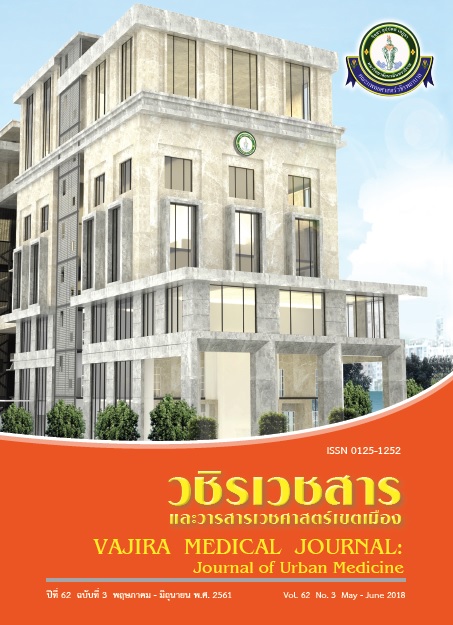Prevalence and Risk Factors of Childhood Obesity at Well Child Clinic
Main Article Content
Abstract
Objective: To evaluate the prevalence of the obesity and factors associated with obesity in infants and children aged 4 months - 5 years at well child clinic.
Method: The cross-sectional descriptive study was conducted by interviewing the caregivers of infants and children aged 4 months – 5 years who visited well child clinic, Department of Pediatrics, Faculty of Medicine Vajira Hospital during September 2012 to September 2013.
Results: Of 150 infants and children enrolled in this study, 65 (43.3%) were infants aged 4-12 months and 85 (56.7%) were children aged 1-5 years. The prevalence of obesity in infants and children in this study was 3.3% (1.5% in infants and 4.7% in children). The factors associated with obesity in infants were usage of follow-on formula (p-value 0.04) and number of complementary food (p-value 0.01). Overweight and obese infants received follow-on formula and complementary food more than the rest. The factors associated with obesity in children were number of meal intake (p-value 0.03), number of snack intake (p-value 0.03) and eating while watching television or using electronic media (p-value 0.01). Overweight and obese children consumed more meals and snacks and ate while watching television or using electronic media more than the rest.
Conclusion: The prevalence of obesity in infants and children in this study was 3.3% (1.5% in infants and 4.7% in children). Factors associated with overweight and obesity in infants and children included usage of follow-on formula, number of complementary food, meals and snacks as well as eating while watching television or using electronic media.
Downloads
Article Details
References
2. World Health Organization. Childhood overweight and obesity. [internet]. 2017. [cited 2017 May 5] Available from: http://www.int/dietphysicalactivity/childhood/en.
3. Jitnarin N, Kosuwat V, Rojroongwasinkul N, Boonpraderm A, Haddock CK, Poston WS. Prevalence of overweight and obesity in Thai population: results of the National Thai Food Consumption Survey. Eat Weight Disord. 2011;16:e242-9.
4. วิชัย เอกพลากร. รายงานการสำรวจสุขภาพประชาชนไทยโดยการตรวจร่างกายครั้งที่ 4 พ.ศ.2551-52: สุขภาพเด็ก.สำนักงานสำรวจสุขภาพประชาชนไทย สถาบันวิจัยระบบสาธารณสุข. นนทบุรี: เดอะกราฟิโก ซิสเต็มส์, 2554.
5. Dietz WH. Health consequences of obesity in youth: childhood predictors of adult disease. Pediatrics. 1998;101(Suppl 2):S518–25.
6. Dixon JB. The effect of obesity on health outcomes. Mol Cell Endocrinol. 2010;316:104–8.
7. Gahagan S. Overweight and obesity. In: Kliegman RM, Stanton BF, St. Geme JW, Schor NF, Behrman RE, eds. Nelson textbook of pediatrics. 20th ed. Philadelphia: Elsevier Saunders, 2016. p.307-16.
8. Garver WS. Gene –diet interactions in childhood obesity. Curr Genomics. 2011;12:180-9.
9. Arenz S, Ruckerl R, Koletzko B, von Kries R. Breast-feeding and childhood obesity: a systematic review. Int J Obes Relat Metab Disord. 2004;28:1247-56.
10. Epstein LH, Gordy CC, Raynor HA, Beddome M, Kilanowski CK, Paluch R. Increasing fruit and vegetable intake and decreasing fat and sugar intake in families at risk for childhood obesity. Obes Res. 2001;9:171-8.
11. Ludwig DS, Peterson KE, Gortmaker SL. Relation between consumption of sugar-sweetened drinks and childhood obesity: a prospective, observational analysis. Lancet. 2001;357:505-8.
12. Craoli M, Argentierti L, Cargone M, Masi A. Role of television in childhood obesity prevention. Int J Obes Relat Metab Disord. 2004;28 suppl 3;S104-8.
13. Plourde G. Preventing and managing pediatric obesity. Recommendations for family physicians. Can Fam Physician. 2006;52:322-8.
14. Johnston BD, Huebner CE, Anderson ML, Tyll LT, Thompson RS. Healthy steps in an integrated delivery system: child and parent outcomes at 30 months. Arch Pediatr Adolesc Med. 2006;160:793-800.
15. Waters E, de Silva-Sanigorski A, Hall BJ, Brown T, Campbell KJ, Gao Y, et al. Interventions for preventing obesity in children. Cochrane Database Syst Rev. 2011:CD001871.
16. Brotman LM, Dawson-McClure S, Huang KY, Theise R, Kamboukos D, Wang J, et al. Early childhood family intervention and long-term obesity prevention among high risk minority youth. Pediatrics. 2012;129:e621-8.
17. WHO Multicentre Growth Reference Study Group. WHO Child Growth Standards based on length/height, weight and age. Acta Paediatr.2006 Suppl;450:S76–85.
18. นิตยา คชภักดี, นิชรา เรืองดารกานนท์, ชัยยศ คุณานุสนธิ์. สุขภาพและพัฒนาการของเด็กไทย พ.ศ. 2539-2540.
19. ลัดดา เหมาะสุวรรณ, ศิริกุล อิศรานุรักษ์, นิชรา เรืองดารกานนท์, สุธรรม นันทมงคลชัย, ภัทรา สง่า, กัลยา นิติเรืองจรัส, จิราพร ชมพิกุล, และคณะวิจัยโครงการวิจัยพัฒนาการแบบองค์รวมของเด็กไทย. เด็กไทยวันนี้เป็นอยู่อย่างไร. หาดใหญ่: ลิมบราเดอร์ส การพิมพ์จำกัด, 2547.
20. Koletzko B, von Kries R, Closa R, Escribano J, Scaglioni S, Giovannini M, the European Childhood Obesity Trial Study Group. Lower protein in infant formula is associated with lower weight up to age 2 y: a randomized clinical trial. Am J Clin Nutr. 2009;89:1836-45.
21. Escribano J, Luque V, Ferre N, Mendez-Riera G, Koletzko B, Grote V, the European Childhood Obesity Trial Study Group.Effect of protein intake and weight gain velocity on body fat mass at 6 months of age: The EU Childhood Obesity Programme. Int J Obes. 2012;36:548-53.
22. อุมาพร สุทัศน์วรวุฒิ, สุภาพรรณ ตันตราชีวธร, สมโชค คุณสนอง, บรรณาธิการ. คู่มืออาหารตามวัยสำหรับเด็กเล็ก. กรุงเทพฯ: บียอนด์ เอ็นเทอร์ไพรซ์; 2552.
23. Robinson TN. Reducing children's television viewing to prevent obesity: a randomized controlled trial. JAMA. 1999;282:1561-7.
24. Gregori D, Foltran F, Ghidina M, Berchialla P. Understanding the influence of the snack definition on the association between snacking and obesity: a review. Int J Food Sci Nutr. 2011;62:270-5.
25. Ong KK, Loos RJF. Rapid infancy weight gain and subsequent obesity: Systematic reviews and hopeful suggestions. Acta Paediatr. 2006;95:904-8.
26. Monteiro PO, Victora CG. Rapid growth in infancy and childhood and obesity in later life: a systematic review. Obes Rev. 2005;6:143-54.
27. Dennison BA, Boyer PS. Risk evaluation in pediatric practice aids in prevention of childhood overweight. Pediatr Ann. 2004;33:25-30.
28. Gidding SS, Dennison BA, Birch LL, Daniels SR, Gillman MW, Lichtenstein AH, et al. Dietary recommendations for children and adolescents: a guide for practitioners. Pediatrics. 2006;117:544-59.
29. สุนทรี รัตนชูเอก, พัชราภา ทวีกุล, อรวรรณ เอี่ยมโอภาส, อุมาพร สุทัศน์วรวุฒิ, บรรณาธิการ. แนวทางเวชปฏิบัติการป้องกันและรักษาโรคอ้วนในเด็ก พ.ศ. 2557. [internet]. 2014. [cited 2017 May 15]. Available from:http://www.thaipediatrics.org/Media/media-20161208151655.pdf.


